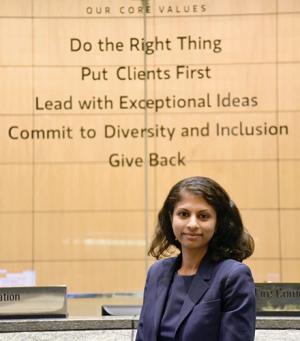Morgan Stanley
Lavanya Balakrishnan is Managing Director, Investment Banking for the Global Power and Utilities Group at Morgan Stanley.
The pandemic perhaps made it more obvious that the energy and utilities industries increased their focus on people. The financial industry did too, as regulators and policymakers across businesses paid more attention to Environmental, Social and Governance criteria.

It is more common now to find that financial institutions have integrated ESG and sustainability into their corporate strategies, investments, and culture. Whether making the move first or pushed by activists, ESG is here to stay.
PUF delves into what the ESG trend has changed in the financial services industry by speaking with an expert at Morgan Stanley. Here, Lavanya Balakrishnan, with said company, enlightens readers on what it all means for the utility sector too.
PUF's Steve Mitnick: The ESG trend is growing and having an impact on all aspects of our business.
Lavanya Balakrishnan: In all our conversations at Morgan Stanley with clients or investors, the topic of Environmental, Social and Governance issues comes up. That wasn't the case just a few years back.
 Lavanya Balakrishnan in front of Morgan Stanley’s Core Values, which are displayed in the lobby of every one of Morgan Stanley’s office’s around the world.
Lavanya Balakrishnan in front of Morgan Stanley’s Core Values, which are displayed in the lobby of every one of Morgan Stanley’s office’s around the world.
Especially in the power utility sector, ESG has become part of company strategy. It's inherent in the way companies in our space need to operate, tell their stories to investors, and position themselves with regulators and policymakers.
From an investor's perspective, they're expecting ESG not to be only an investor relations or a sustainability officer function. This is something investors want to hear from the CEO and the board.
ESG impacts everything: the way companies trade, the way they are growing, and their M&A strategy, as well as how shareholder activists are screening companies and sectors. It has implications across a wide range of variables.
Looking broader, Morgan Stanley as a bank, is committed to integrating ESG considerations across all our business practices and operations. This includes assessing what we finance, managing our supply chain, improving the resilience of our operations, and fostering an inclusive workforce. Morgan Stanley has committed to net-zero financed emissions by 2050 and carbon neutral operations by 2022.
PUF: What do you do at your bank, and what is your typical day like?
Lavanya Balakrishnan: I'm a Managing Director in Morgan Stanley's Power and Utilities group within investment banking. I cover many of the large-cap, mid-cap, and unregulated power companies. I also spend a lot of time with some newer and emerging renewable companies. I've been with the firm and the power and utilities group for about fifteen years and have worked with managing director Caren Byrd all that time, too.
More broadly, I'm associated with many of the initiatives that Morgan Stanley is doing at a firm level on ESG. The power and utility sector is leading the way. Part of that has to do with our sector's historically having been more carbon-heavy.
We spend a lot of time on M&A and capital markets executions. That's across equity, debt financing, and project financing. All our clients need capital especially for rebuilding the grid and supporting renewable generation.
PUF: What trends are you seeing from the ESG investors?
Lavanya Balakrishnan: Earlier this year we were seeing, on a monthly flow basis, north of sixty billion dollars coming into ESG sustainability funds globally. This has leveled out to forty-five to fifty billion dollars a month recently, but that's still at record levels.
One stat that I often use is that we saw about three hundred thirty billion dollars of funds come into ESG investments in 2020. This was during a time when there was a disruption in the broader market because of COVID.
That just points out that ESG is not just a cyclical but rather a secular trend. We're seeing that theme even in more volatile markets. ESG investors are across the board in all types of securities. It's become inherent to investor strategies.
European equity investors are paving the way. They're a step ahead of U.S. investors in terms of having more stringent environmental screens that they use to assess potential investments. We've heard of situations where there are certain European funds that won't put any money to work if a company has any coal exposure. Most U.S. investors are not there yet.
PUF: What about green bonds? Explain pricing differentials.
Lavanya Balakrishnan: Green bonds simplistically are debt instruments issued with a specific use of proceeds that's green in nature. A company can say, "I'm raising two hundred million and am planning on putting that to work for renewable projects that I have penciled in already."
Those capital-raising activities are being rewarded by investors through the pricing — i.e., the coupon rate. To date, the coupon differential is not that much — depending on how it is measured, it can be about five to ten basis points; but over the long run, these are real savings for our clients and their customers.
PUF: ESG investing is having a big effect on corporate strategy. What are you seeing?
Lavanya Balakrishnan: Across M&A, ESG has become an additional lens that our clients are using. As a specific example, I was recently engaged in an M&A exercise with a client looking at potential acquisition opportunities. One of the things they wanted to look at was if they acquired a target, how does this enhance or detract from their strategy to cut carbon emissions over the next ten years.
Historically, when we do M&A analysis for our clients it's based on a strategic rationale. We look at a lot of numbers around the financial impact, the rating agency impact. On top of that we're now assessing how does this enhance our client's ESG strategy.
One of the clients that I cover is Dominion. Last year Dominion sold its gas transmission and storage business to Berkshire Hathaway, and we worked with Dominion on that. One of the ways Dominion positioned that deal to investors was that this sale of a big part of their company enhanced the ESG story of Dominion going forward. The asset sold was carbon-intensive. Dominion said that once the business was sold, it would see on day one carbon dioxide emissions cut by fifty percent. That was a powerful stat and one that resonated with the company's investors.
Dominion was able to tell the market it was getting away from these carbon-heavy businesses. In addition to this divestiture, Dominion is building a large offshore wind project that's been supported by regulators in Virginia as it improves its carbon footprint.
PUF: ESG includes diversity of the workforce, transparency, and ethics. Sometimes executive compensation comes into play.
Lavanya Balakrishnan: Yes. The E has been easiest to quantify. That's where we've seen the most impact. The S is interesting, and it's come up more through the societal events that we saw last year.
Questions are being raised around what companies are doing in their communities, are companies diverse enough, and how they treat their various stakeholders. This impact has been harder to measure.
We're seeing many companies taking proactive steps in these areas, which they share in their sustainability reports. This is forcing companies to be more transparent about how they're reporting, but these are primarily qualitative in nature. Investors are trying to put their arms around these, especially the S factor.
Then G, the governance, has always been something that has come up over and over again, especially around shareholder activism. When we look historically at which attack vectors shareholder activists have focused on, governance has been front and center. We hear such issues as your board is not diverse enough, you have certain board members that have been around too long, and there aren't enough women or minorities on the board.
We're also seeing newer activists get into the picture. This is a little outside our space, but we saw this at Exxon with Engine No. 1, in its shareholder activist campaign. They got three of their own board members onto the Exxon board, and it was focused on their criticism of what Exxon was doing, especially around energy transition. Folks in our industry have been asking about the Exxon case study because it overlaps with energy transition.
There are third parties spending time looking at how companies are thinking about executive compensation and ESG. What we've found is that boards are starting to measure ESG performance as one of the factors when they look at how they're paying their executives.
Some studies have found that it's having more impact on the shorter-term compensation. When we look into the one-year pay or shorter-term versus long-term incentive planning, it's interesting. Xcel Energy has been one of the first companies in the utility industry that has ESG factor into how they're awarding compensation. This is indicative of boards holding the management team accountable for ESG goals.
PUF: What should regulators and state government leaders know about this ESG trend?
Lavanya Balakrishnan: It's become central to company strategy and where companies are going to be putting money to work. Investors are pressuring companies to decarbonize and shut down coal, as they look to clean up portfolios. New capital is going to work in wind, solar, energy storage, and newer technologies.
That has implications around how companies are going to go to the capital markets and raise capital. Regulators should be aware that ESG is central. It's going to come up when they're looking at risks facing companies and assessing the cost of capital in ratemaking. It's going to impact how companies are going to grow and how their securities are going to trade.
PUF: What should utilities' leaderships be thinking about where ESG is going?
Lavanya Balakrishnan: It's here to stay. We tell all of our clients that this is a board-level issue.
Companies are trying to assess what strategic steps they can take to better position themselves versus their competitors. They are asking where they can put their money to grow and how they can position their companies so they are more proactive than reactive.
PUF: Natural gas is increasingly becoming an issue, and many companies have turned to gas-fired generation. What should they be thinking about for these pressures?
Lavanya Balakrishnan: It comes up a lot. It's going to be hard to get to one hundred percent renewables without gas when we don't have energy storage that can function at a mass level. Gas is widely regarded as a required transition fuel. We need it as part of a diversified fuel mix.
Where there's more pushback is companies that have gas pipelines, like oil- and gas-type businesses versus your typical state-regulated gas LDCs. For the companies owning pipelines, like the assets Dominion owned in the gas business, those are the type of assets that get more pushback. The question is why do you need to own those types of businesses?
PUF: What do you find most rewarding in this important area of ESG?
Lavanya Balakrishnan: The most exciting is we're in the midst of change and that's a fascinating aspect of our sector. There are so many forces driving this change. Ten years ago, I would not have thought we would be talking so much about environmental and renewable factors.
This has become mainstream and we as bankers get to advise our clients on this important transition. These are clients at the top of their organization. In talking about these important topics, we can change the way they're thinking about the strategic direction of their companies.
Caren Byrd: We're making goals that are set for 2050 that are going to affect the lives of the next generation. These are things that we can facilitate with financing and helping with better strategy, which gives us a lot of personal gratification.


